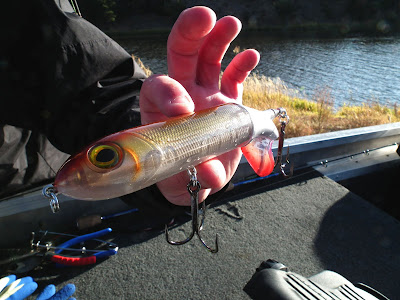 |
| Matt Pelletier of New Mexico Muskie's Inc at Quemado Lake, Fall 2010.Photo courtesy of Pelletier. |
It’s New Mexico’s latest fishing craze, anglers trying to catch giant, 40-inch, 20-pound tiger muskies lurking in the depths of Quemado and Bluewater lakes where they’ve been stocked to prey upon undesirable fish.
“People are coming from all over the place to catch these,” says Matt Pelletier of New Mexico Muskies Inc., a newly formed, non-profit club, dedicated to the sport. “And it’s a real rush when you get into one.”
The predators, a cross between a muskie and a pike produce a sterile hybrid that can be raised in hatcheries and then stocked in lakes to help control undesirable fish populations.
 |
| A tiger muskie falls victim to an imitation goldfish lure. |
These kinds of undesirable fish compete with sport fish, like trout, for the available habitat which in turn leads to reduced angler satisfaction at these locations. At one point Quemado Lake was virtually overrun with goldfish and trout fishing was almost nonexistent.
But the stocked tiger muskies have gone about their deadly work for several years, chasing down and eating their intended victims and some anglers have since turned to catching them, strictly on a required catch and release basis.
But the tiger muskies have done such a good job in reducing the undesirable fish populations at both lakes that the state Game Commission has recently ruled that anglers can now catch and keep a trophy size tiger muskie from either lake.
 |
| Tiger muskies under 40-inches length have to be returned to the water. |
Surveys results lead researches to believe that Quemado Lake holds a population of about 1,100 Tiger Muskies over 18-inches in length. During the fall electro shocking survey 30 tiger muskies were netted with the average size coming in at 33-inches and the largest weighing in at 19-pounds and 43-inches in length.
During the same survey 62 trout were caught with the average size being 18-inches indicating the popular sport fish is thriving in Quemado Lake despite the addition of larger predators to the environment.
 |
| The trout have returned to Quemado Lake. |
That’s good news for trout anglers who in recent years may have given up on Quemado Lake.
An early November trip to the lake on a warm sunny Saturday revealed good fishing with several young tigers netted along with a trophy sized trout and a giant grass carp.
| A monster carp inadvertently hooked while trolling at Quemado Lake. |
Pelletier says his organization was formed to help educate anglers about the sport and assist the state in improving, protecting and promoting the tiger muskie fisheries.
For instance, the club raised $5,400 through a grant from the Hugh C. Becker Foundation to purchase minnows to feed tiger muskies being reared at the state’s Rock Lake Fish Hatchery. This helps keep the young predators from preying on each other while raised at the hatchery.
The club boasts 56 members, welcomes new anglers and meets about once a month in the Albuquerque area. The meetings are open to the public, Pelletier says.
Anglers wishing to fish for tiger muskies should be aware of some special equipment needed to do so successfully.
 |
| Tiger muskie lures come in all shapes and sizes. |
Anglers should be equipped with a pair of long, needle nose pliers for dislodging hooks. A pair of heavy nippers for cutting hooks off if needed and a pair of jaw spreaders to open the fish’s mouth and get at embedded hooks.
 |
| Tiger muskie should be handled with extreme care due to their teeth. |
“We practice and preach catch and release to conserve the resource,” Pelletier says.
Those fishing for tiger muskies need to practice patience and persistence as the fish feed on a limited schedule and anglers need to have their lures in the water when that occurs, Pelletier says.
 |
| A boat is nice but most tiger muskies are caught right from the bank, Pelletier says. |
The key to attracting a strike from a tiger muskie is to capitalize on its opportunistic, predatory instinct with jerks and motion of the lure that imitate a wounded or struggling prey, Pelletier said.
For more information about the fish, catch and release techniques and some awesome photos check out the club’s website at http://www.newmexicomuskiesinc.org.
 |
| An Osprey enjoys a fish snatched from Quemado Lake and is another sign of a healthy fishery. |
If You Go:
From Santa Fe take I-25 south to I-40, head west to exit 89 and NM 117. Head south through the Malpais, taking time to stop and check out the BLM visitor center, the natural arch and the black lava flows. Follow this lonly stretch of blacktop down to NM 36 and on to Quemado. Head west on US 60 a short distance past town and then take NM 32 to the turnoff to Quemado Lake. Campsites with restrooms are available in the forest on the far side of the lake off Forest Road 103.
For an alternate route home, don't leave the way you came in, instead keep going past the the lake on Forest Road 13, up across Slaughter Mesa and then drop down off the mountain onto Forest Road 218 which leads to State Highway 12. Follow the highway to the intersection of US 60 at Datil. There's a bar, cafe, general store and gas to be had here. Follow US 60 past the very large array to Magdalena and on to Socorro and I-25 north to Albuquerque and Santa Fe. A very scenic drive and then a quick ride home on the interstate.
 |
| The Very Large Array on the Plains of San Augustin. |










No comments:
Post a Comment